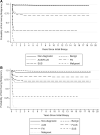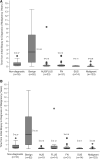A Large Thyroid Fine Needle Aspiration Biopsy Cohort with Long-Term Population-Based Follow-Up
- PMID: 33371796
- PMCID: PMC9469749
- DOI: 10.1089/thy.2020.0689
A Large Thyroid Fine Needle Aspiration Biopsy Cohort with Long-Term Population-Based Follow-Up
Abstract
Background: Prior studies evaluating thyroid fine needle aspiration biopsies (FNABs) have limited the calculation of risk of malignancy (ROM) to cytologic specimens with corresponding histologic specimens, and clinical follow-up for those patients who do not undergo immediate surgery has been largely disregarded. Moreover, there is marked variability in how researchers have approached thyroid FNAB statistical analyses. This study addresses the urgent need for information from a large cohort of patients with long-term clinical follow-up to more accurately determine the performance of thyroid FNAB and ROM for each diagnostic category. Methods: A retrospective review of the University of California, San Francisco (UCSF), pathology database for thyroid FNABs from January 1, 1997, to December 31, 2004, was performed. Diagnoses were coded using the 2017 The Bethesda System for Reporting Thyroid Cytopathology (TBSRTC), and patients were matched to both the UCSF cancer registry and California Cancer Registry. Data were analyzed using the Kaplan-Meier method, and stratified by TBSRTC diagnostic category. Kaplan-Meier curves were used to estimate incidence rates of malignancy, stratified by FNAB category. Cox proportional hazards models were used to determine the instantaneous ROM. Results: Initial FNABs from 2207 patients were included. Median follow-up period after the first thyroid FNAB was 13.9 years (range: 10.5-18.4 years). During follow-up, there were 279 confirmed diagnoses of thyroid malignancy. Estimates derived from Kaplan-Meier curves demonstrated that the risk of having a thyroid malignancy was low for nondiagnostic and benign categories, intermediate for atypia of undetermined significance (AUS), follicular lesion of undetermined significance (FLUS), AUS/FLUS combined, and follicular neoplasm, and high for suspicious and malignant categories. A total of 52/1575 false-negative cases (3.2%) were identified. Excluding papillary microcarcinomas, the false-negative rate was 1.5% (23/1575). No patients with a false-negative diagnosis died of thyroid cancer during the follow-up period. Conclusions: Asymptomatic patients with low-risk clinical and radiologic features and initially benign or unsatisfactory biopsy are unlikely to develop thyroid malignancy and highly unlikely to die of thyroid cancer. FNAB is highly accurate in detecting malignancy. Additional studies evaluating similar large data sets after the adoption of TBSRTC and the integration of molecular testing are needed.
Keywords: Bethesda; adequacy; cytopathology; fine-needle aspiration biopsy; thyroid.
Conflict of interest statement
No competing financial interests exist.
Figures



Similar articles
-
Impact of reclassifying noninvasive follicular variant of papillary thyroid carcinoma on the risk of malignancy in The Bethesda System for Reporting Thyroid Cytopathology.Cancer Cytopathol. 2016 Mar;124(3):181-7. doi: 10.1002/cncy.21631. Epub 2015 Oct 12. Cancer Cytopathol. 2016. PMID: 26457584
-
Malignancy rate in thyroid nodules classified as Bethesda category III (AUS/FLUS).Thyroid. 2014 May;24(5):832-9. doi: 10.1089/thy.2013.0317. Epub 2014 Mar 10. Thyroid. 2014. PMID: 24341462 Free PMC article.
-
Reproducibility of atypia of undetermined significance/follicular lesion of undetermined significance category using the bethesda system for reporting thyroid cytology when reviewing slides from different institutions: A study of interobserver variability among cytopathologists.Diagn Cytopathol. 2017 May;45(5):399-405. doi: 10.1002/dc.23681. Epub 2017 Feb 20. Diagn Cytopathol. 2017. PMID: 28217980
-
High risk of malignancy in cases with atypia of undetermined significance on fine needle aspiration of thyroid nodules even after exclusion of NIFTP.Diagn Cytopathol. 2020 Nov;48(11):986-997. doi: 10.1002/dc.24533. Epub 2020 Aug 3. Diagn Cytopathol. 2020. PMID: 32745375
-
Follow-up of atypia and follicular lesions of undetermined significance in thyroid fine needle aspiration cytology.Cytopathology. 2013 Dec;24(6):385-90. doi: 10.1111/cyt.12021. Epub 2012 Oct 18. Cytopathology. 2013. PMID: 23078633 Review.
Cited by
-
2021 Korean Thyroid Imaging Reporting and Data System and Imaging-Based Management of Thyroid Nodules: Korean Society of Thyroid Radiology Consensus Statement and Recommendations.Korean J Radiol. 2021 Dec;22(12):2094-2123. doi: 10.3348/kjr.2021.0713. Epub 2021 Oct 26. Korean J Radiol. 2021. PMID: 34719893 Free PMC article. Review.
-
Transoral vestibular robotic thyroidectomy in pediatric thyroid disease: 5 case reports.Endocrine. 2025 May;88(2):523-528. doi: 10.1007/s12020-025-04178-y. Epub 2025 Feb 10. Endocrine. 2025. PMID: 39928250 Free PMC article.
-
Thyroid Cancer Detection in a Routine Clinical Setting: Performance of ACR TI-RADS, FNAC, and Molecular Testing in Prospective Cohort Study.Biomedicines. 2022 Apr 20;10(5):954. doi: 10.3390/biomedicines10050954. Biomedicines. 2022. PMID: 35625691 Free PMC article.
-
Towards De-Implementation of low-value thyroid care in older adults.Curr Opin Endocrinol Diabetes Obes. 2022 Oct 1;29(5):483-491. doi: 10.1097/MED.0000000000000758. Epub 2022 Jul 22. Curr Opin Endocrinol Diabetes Obes. 2022. PMID: 35869743 Free PMC article. Review.
-
Detection of BRAF V600E in Fine-Needle Aspiration Samples of Thyroid Nodules by Droplet Digital PCR.Int J Endocrinol. 2022 Mar 29;2022:6243696. doi: 10.1155/2022/6243696. eCollection 2022. Int J Endocrinol. 2022. PMID: 35392249 Free PMC article.
References
-
- Haugen BR, Alexander EK, Bible KC, Doherty GM, Mandel SJ, Nikiforov YE, et al. . 2016. 2015 American Thyroid Association Management Guidelines for Adult Patients with Thyroid Nodules and Differentiated Thyroid Cancer: The American Thyroid Association Guidelines Task Force on Thyroid Nodules and Differentiated Thyroid Cancer. Thyroid 26:1–133. - PMC - PubMed
-
- Howlader N, Noone AM, Krapcho M, Miller D, Brest A, Yu M, Ruhl J, Tatalovich Z, Mariotto A, Lewis DR, Chen HS, Feuer EJ, Cronin KA (eds) SEER Cancer Statistics Review, 1975–2016, Bethesda, MD, based on November. 2018. SEER data submission, posted to the SEER web site, April 2019. Available at https://seer.cancer.gov/csr/1975_2016 (accessed November 20, 2020).
-
- Cibas ES, Ali SZ, NCI Thyroid FNA State of the Science Conference. 2009. The Bethesda System For Reporting Thyroid Cytopathology. Am J Clin Pathol 132:658–665. - PubMed
-
- Cibas ES, Ali SZ. 2017. The 2017 Bethesda system for reporting thyroid cytopathology. Thyroid 27:1341–1346. - PubMed
-
- Bongiovanni M, Spitale A, Faquin WC, Mazzucchelli L, Baloch ZW. 2012. The Bethesda system for reporting thyroid cytopathology: a meta-analysis. Acta Cytol 56:333–339. - PubMed
MeSH terms
Grants and funding
LinkOut - more resources
Full Text Sources
Other Literature Sources
Medical

